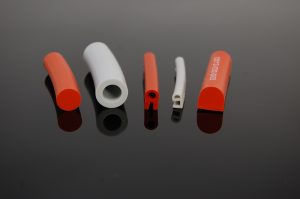Happy Halloween from Elasto Proxy! To celebrate, we’re hosting a fun-filled family event here at our Boisbriand, Quebec headquarters. A Halloween party needs pumpkins, of course, and our Montreal-area facility has enough water jet cutters to scare away all the other types of cutting equipment. So, we’re planning to water jet cut our pumpkins – and with intricate designs suggested by our team. Kids of all ages will have a frighteningly good time watching this precision pumpkin carving in action.
Why Water Jet Cutting is Scary Good
Water jet cutting is fast and accurate but sometimes misunderstood. Among metal fabricators, it usually refers to abrasive water jet cutting, a version of the process that mixes a garnet abrasive with a highly pressurized stream of water. Among rubber fabricators, however, water jet cutting typically refers to pure water jet cutting, which uses a highly pressurized stream of water without an abrasive material.
In general, pure water jet cutting is used to convert softer, thinner materials like rubber and plastic sheets. It can also be used with rubber and plastic extrusions, thermal and acoustic foams, thin metal foils, and industrial fabrics. Abrasive water jet cutting is used mainly for harder, thicker materials like metals and composites. It’s also used to convert rubber products that contain metal inserts.
With both types of water jet cutting, there’s never any tooling to wait for or pay for. That makes it a great choice for quick-turn prototyping and low-to-medium volume production. For clean edges, perfect 90° corners, and precision holes and notches, water jet cutting puts the trick in trick or treat all year long. But is it really the best way to cut parts like seals, gaskets, and insulation?
Why You Wouldn’t Die Cut a Pumpkin
Water jet cutting isn’t the only way to cut materials, of course, and there’s a place for techniques like die cutting if you need high volumes. But consider what Halloween pumpkins can teach us about tooling. If you designed a die for a jack o’lantern today, you probably wouldn’t receive it until just before Christmas. That’s too long to wait when you need a finished part for October 31st.
Then, when you received that die, you’d be as disappointed as if you’d found coal in your stocking on Christmas morning. That’s because die-cutting is for sheet materials. It’s not for objects like pumpkins – and it’s certainly not for rubber or metal extrusions. With water jet cutting, however, a fabricator can cut both sheets and extrusions – and without the rough edges that die cutting imparts to softer materials.
Pumpkins are relatively soft, but they’re not too soft for cutting equipment that pressurizes water in tens of thousands of pounds per square inch (PSI). It’s easy enough to adjust the water pressure based on the material. Phillippe Greiner, our Production Manager, does just that and uses a Halloween trick of putting wood inside the pumpkin so that the water jet won’t cut all the way through.
Here’s another reason to use water jet cutting for parts fabrication. When each design is different, such as with carved pumpkins, it doesn’t make sense to pay for tooling you’ll use once and then discard. That’s a lot like prototyping. Until your design is final, any die that you buy might become obsolete. Then, if you need a small volume of parts, it can be tough to justify the cost of a tool.
Water Jet Cutting from Elasto Proxy
Water jet cutting is a proven way to produce precise parts. So, don’t believe those old ghost stories you might hear. Water jet cut parts aren’t soaked, and there isn’t a big mess to clean up every time. With abrasive water jet cutting, the sand is reusable. The same technology that can carve pumpkins can provide you with the parts you need. On Halloween and all year long, we think that’s worth celebrating.









